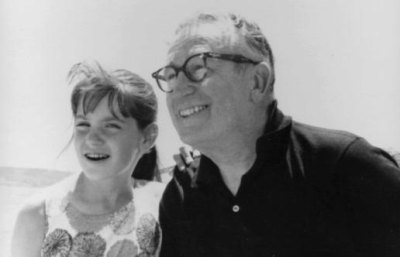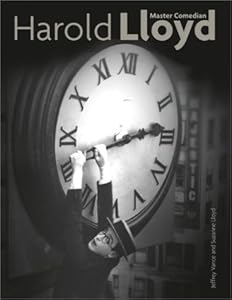This is the second part of a two-part interview with Harold Lloyd's granddaughter, Suzanne Lloyd, in honor of Bryn Mawr Film Institute's screening of Safety Last! on June 25. Read the first part here.
Harold Lloyd keeps his granddaughter Suzanne quite busy. As the caretaker for his collection, she is responsible for preserving one of the largest private film libraries in the world and introducing the silent comedy legend to new audiences. Her grandfather’s film library gets around so much, in fact, that she laughingly calls the collection “Harold”, as if it is a person, “because ‘he’ is so busy.” (She lovingly refers to the man himself as “Dad”.)
A Grandfather’s Gifts
Suzanne was granted a very special view into classic Hollywood from a young age. She was raised at Greenacres, her grandparents’ estate in Beverly Hills, where she was neighbors with the likes of Cary Grant and schoolmates with the daughters of Jimmy Stewart, William Wellman, and Randolph Scott.
“One of [my grandfather’s] dearest friends was Doug Fairbanks—his best friend—and Mary Pickford was one of my grandmother’s best friends. I used to go to see ‘Aunt Mary’ all the time. She had great cookies, nice dogs. Colleen Moore was my godmother. I had no idea who they were. You just accept them as your grandparents’ friends. I got a clue who Walt Disney was when I was older. He had a train in his backyard, and when we went to Disneyland, I put it together that it was named for the same guy with the train.”
 |
| Suzanne Lloyd with her grandfather, Harold. |
When Harold passed away in 1971, Suzanne was only nineteen-and-a-half years old, but she was entrusted with the task of protecting his legacy and managing his film library, a responsibility for which Harold had been unofficially grooming her for years.
“It was a real privilege. But I worked on the films with him before he died and I really knew them. I used to go lectures with him. I went to the opening of the American Film Institute. When about fifteen, I started I started working on the films with him at the house with a couple of film students.
“My first job was to clean, rewrap, and air out nitrate film. Have you ever smelled nitrate film? It’s not fun. Dad said, ‘This is a good way to break you in. Film isn’t fun, it’s hard work. You need to know the elements of film before you can do more.’”
He arranged for Suzanne to take film classes at USC when she was just a senior in high school. Although Harold had retired in 1947, before Suzanne was born, if friends were shooting a movie, he’d take her to visit the sets.
“Robert Wise was shooting Star at Fox. I’d just broken my leg—it was a bad break. I couldn’t go to school. Dad called him up and said, ‘Listen, Bob, I’m trying to give Sue an overview of stuff, but I’m not on set anymore.’ So I went down to the set and they put me in one of the director’s chairs every day while they worked. I put my leg up; the grips just moved the chair around. For two or three weeks, I just sat there, every day. ‘Just sit there, take notes,’ they told me.” She did.
Passing the Torch
“He was very good about passing on torches and helping others. He started a lot of people’s careers,” Suzanne recalls. Jack Lemmon’s son, Chris, was born in Harold’s beach house, where Harold let Jack and his wife live while Jack was starting out as an actor. Robert Wagner was introduced to Harold through Suzanne’s mom, and he became close with the Lloyd family. “Dad said, ‘Well, maybe we’d better get you an agent.’ That led to his first job.”
And those young film students that worked with Suzanne to help Harold archive his films? “They were Rich Correll—the son of Charles Correll, who played Andy in Amos and Andy—and David Nowell, who’s now one of the top aerial cinematographers in the world. Richard is one of the creators of Hannah Montana. He did the restorations on the new shorts for Turner Classic Movies, and he still has me rewinding the film and marking the positions. I never seem to have gotten out of that!” Suzanne reflects with a hearty laugh.
In the decades since Suzanne has assumed responsibility for preserving Harold Lloyd’s film library, she has introduced his work to new audiences in numerous ways. In addition to presenting his newly restored films at festivals worldwide and on Turner Classic Movies, she also co-authored the 2002 book Harold Lloyd: Master Comedian, has compiled two books of his 3-D photographs, and was the executive producer for the Emmy-nominated British documentary, Harold Lloyd: The Third Genius.
“It’s Harold’s Job”
I asked Suzanne what has surprised her most about Harold over the years, and if there were things that she is still learning about him through his working with his films.
“I had to really learn to do public speaking when I was young. The first time I went out to introduce the films I was nervous. This archivist who had worked on them said, ‘Speak from your heart. Just remember, the moment that Harold gets up there, it’s Harold’s job. He knows what to do, he’s always known what to do.’ The laughter and reactions to his films are just amazing, year after year. I wish I could have been there in the beginning, but they are so consistent, I bet it’s the same as it is now. You need to see his films with an audience. People who have never seen them come out saying, ‘Why haven’t we seen him? Where has he been?’ That just thrills me and amazes me every time.”
Thanks to Suzanne’s work, the laughs will keep coming and new audiences will continue to be able to discover “Harold”, both the man and his film legacy, for a long time to come.
See the 90th anniversary digital restoration of Safety Last! at Bryn Mawr Film Institute on June 25.
Devin Wachs is the Public Relations Manager for Bryn Mawr Film Institute. She joined BMFI in 2005, following her graduation from Bryn Mawr College. If you send BMFI a message on Facebook or Twitter or are interested in onscreen sponsorships, she's the one who will be in touch!





_with_Harold_Lloyd_and_Mildred_Davis.jpg)

